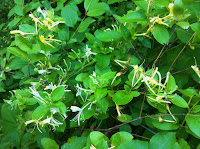When I get an idea, it is an old-fashioned white light bulb.
Let’s see, I could doodle a daisy and
then fill in the petals. When a visual artist gets an idea, it is a
colorful, exploding, prismatic, spiraling light bulb. Let’s see, my brush strokes could give the stylized daisy petals
movement and by gluing bits of colored glass to the canvas … I know anyone
can create art, but my thinking, so far anyway, has not escaped the box. Every
year or so, I visit The Art Institute of Chicago or wander through a special
art exhibit when I travel. But I have not ever been as immersed in art as I was
a few weeks ago.
Normally, in whatever free time exists between appointments
on my calendar, I live by to-do lists. I highlight to-do’s I’ve done, because a
yellow glow on water bean
seeds seems slightly more celebratory than a crossed-off water bean
seeds. This system reminds me of my promises and enables me to progress
toward my highest priorities, which I feel happy about. Fulfillment aside,
however, it is a linear, plodding life.
Although I do not feel bored or trapped in this existence, I
benefit from a change of scenery, especially one that takes me into an enclave
of people committed to creating. Such was my recent trip to Alexandria,
Virginia, to visit my sister, who is a ceramist. Between her and her husband’s
home and her two studios, I was exposed to lots of original art by people who,
at least for a time, did not live by to-do lists. Whether their creations appealed
to my tastes or not, I was awed by the creativity of the artists. How do they
think up this stuff?
In their minds’ eyes, how do they see a man’s face as a mess
of angles? What inspires them to paint a canvas that looks like a multicolored
alpaca fiber weaving? Or overlay tiger stripes on a flower? Or découpage an ostrich eye
with newspaper clippings (very cool, by the way)? Or glue bright beads on each
leaf they paint? Or make a teapot in the shape of a starfish? I cannot even
imagine. My level of artistry is coloring within the lines of my coloring book
and if I dare, coloring something purple that in nature is green.
Professional artists are not just imaginative; they have
learned and practiced technique. Many of them are scientists—they have to know
the chemistry of a glaze or how a kiln forms glass or the characteristics of
certain media, consistency and temperature, for example. My sister and her
ceramics students spend a fair amount of time trimming and testing to be sure
lids fit snugly and spouts pour without dribbling. Functional art might look casual
but it must be precise.
I wonder if following rules and disciplines of your medium
frees you to choose new ways of doing representational art, of abstracting a
subject, or of visually conveying a message. Disciplines lead to freedom in
sports, spiritual pursuits, education, and most professions, so why not arts?
My art immersion happened as I wandered through two art
centers where my sister has her studios, in the Torpedo Factory Art Center in
Alexandria and in the Workhouse Arts Center in Lorton, Virginia, just south of
Alexandria. The actual U.S. Navy torpedo factory was renovated for one hundred
sixty-five professional artists to exhibit their art. In the Workhouse, a
former prison, sixty-five studio artists now work on site. Visitors can tour
galleries in both places to watch artists at work and/or to buy unique pieces.
I was filled with admiration for these painters, potters, glass workers,
jewelry makers, photographers, sculptors.
I don’t have knowledge of these techniques or the commitment
to pursue any at the moment, but I certainly came home thoroughly refreshed.
Hey, maybe I could glue some beads on the leaves in my coloring book. 😊
And maybe my mom would even magnet it to her fridge!
As I oohed and aahed in awe in Workhouse gallery after
gallery, I finally found some art that was about my speed—some students’ chalk
drawings on the sidewalk.

















